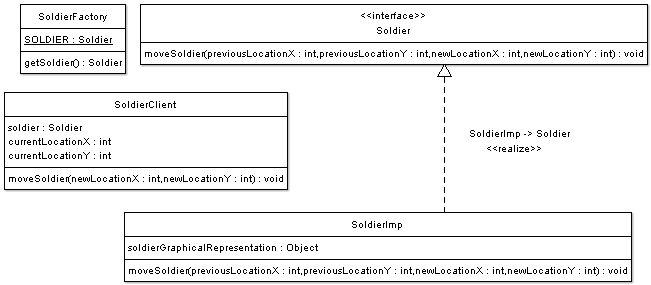|
Flyweight Pattern - WarGame Example - Java Sourcecode |
|
Java Source Code Example for the Flyweight Pattern - WarGame
Consider for example a game of war, were there is a large number of soldier objects; a
soldier object maintain the graphical representation of a soldier, soldier behavior such
as motion, and firing weapons, in addition soldier's health and location on the war
terrain. The solution is to keep the common state of soldiers in a shared object
The war game example instantiates 5 Soldier clients, each client maintains its internal
state which is extrinsic to the soldier flyweight. And Although 5 clients have been
instantiated only one flyweight Soldier has been used.

The code below shows Soldier interface which is the flyweight interface
package flyweight;
/**
* Flyweight Interface
*
*/
public interface Soldier {
/**
* Move Soldier From Old Location to New Location
* Note that soldier location is extrinsic
* to the SoldierFlyweight Implementation
* @param previousLocationX
* @param previousLocationY
* @param newLocationX
* @param newLocationY
*/
public void moveSoldier(int previousLocationX,
int previousLocationY , int newLocationX ,int newLocationY);
}
|
The code below shows the SoldierImp which is the flyweight implementation
package flyweight;
public class SoldierImp implements Soldier {
/**
* Intrinsic State maintained by flyweight implementation
* Solider Shape ( graphical represetation)
* how to display the soldier is up to the flyweight implementation
*/
private Object soldierGraphicalRepresentation;
/**
* Note that this method accepts soldier location
* Soldier Location is Extrinsic and no reference to previous location
* or new location is maintained inside the flyweight implementation
*/
public void moveSoldier(int previousLocationX, int previousLocationY,
int newLocationX, int newLocationY) {
// delete soldier representation from previous location
// then render soldier representation in new location
}
}
|
The code below shows the Soldier Factory from which we instantiate Soldiers Flyweight
package flyweight;
/**
* Flyweight Factory
*/
public class SoldierFactory {
/**
* Pool for one soldier only
* if there are more soldier types
* this can be an array or list or better a HashMap
*
*/
private static Soldier SOLDIER;
/**
* getFlyweight
* @return
*/
public static Soldier getSoldier(){
// this is a singleton
// if there is no soldier
if(SOLDIER==null){
// create the soldier
SOLDIER = new SoldierImp();
}
// return the only soldier reference
return SOLDIER;
}
}
|
The code below shows SoldierClient implementation. The client uses the Flyweight soldier
reference to perform its tasks
package flyweight;
/**
* This is the "Heavyweight" soldier object
* which is the client of the flyweight soldier
* this object provides all soldier services and is used in the game
*/
public class SoldierClient {
/**
* Reference to the flyweight
*/
private Soldier soldier = SoldierFactory.getSoldier();
/**
* this state is maintained by the client
*/
private int currentLocationX = 0;
/**
* this state is maintained by the client
*/
private int currentLocationY=0;
public void moveSoldier(int newLocationX, int newLocationY){
// here the actual rendering is handled by the flyweight object
soldier.moveSoldier(currentLocationX,
currentLocationY, newLocationX, newLocationY);
// this object is responsible for maintaining the state
// that is extrinsic to the flyweight
currentLocationX = newLocationX;
currentLocationY = newLocationY;
}
}
|
The code below shows the war game implementation. Note that war game instantiates 5
Soldier clients, each client maintains its internal state which is extrinsic to the
soldier flyweight. And Although 5 clients have been instantiated only one flyweight
Soldier has been used.
package flyweight;
/**
* Driver : War Game
*/
public class WarGame {
public static void main(String[] args) {
// start war
// draw war terrain
// create 5 soldiers:
SoldierClient warSoldiers [] ={
new SoldierClient(),
new SoldierClient(),
new SoldierClient(),
new SoldierClient(),
new SoldierClient()
};
// move each soldier to his location
// take user input to move each soldier
warSoldiers[0].moveSoldier(17, 2112);
// take user input to move each soldier
warSoldiers[1].moveSoldier(137, 112);
// note that there is only one SoldierImp ( flyweight Imp)
// for all the 5 soldiers
// Soldier Client size is small due to the small state it maintains
// SoliderImp size might be large or might be small
// however we saved memory costs of creating 5 Soldier representations
}
}
|
|
|
